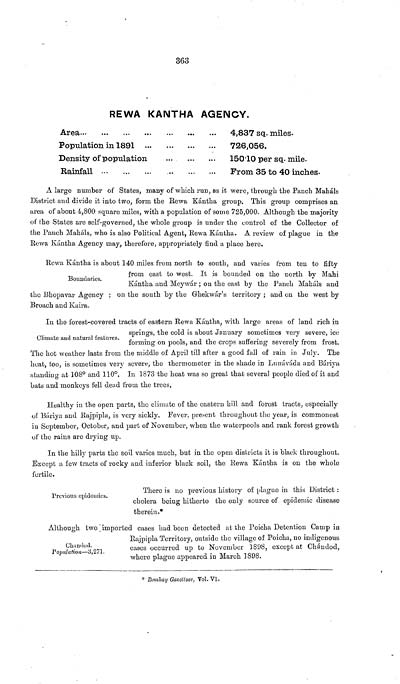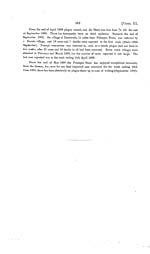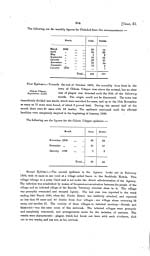Medicine - Disease > Bombay plague: being a history of the progress of plague in the Bombay presidency from September 1896 to June 1899
(450) Page 363
Download files
Individual page:
Thumbnail gallery: Grid view | List view

363
REWA KANTHA AGENCY.
Area ..................... 4,837 sq. miles.
Population in 1891 ............ 726,056.
Density of population ......... 15010 per sq. mile.
Rainfall ......... ......... Prom 35 to 40 inches.
A large number of States, many of which run, as it were, through the Pauch Mahls
District and divide it into two, form the Rewa Kntha group. This group comprises an
area of about 4,800 square miles, with a population of some 725,000. Although the majority
of the States are self-governed, the whole group is under the control of the Collector of
the Pauch Mahls, who is also Political Agent, Rewa Kntha. A review of plague in the
Rowa Kntha Agency may, therefore, appropriately find a place here.
Boundaries.
Rewa Kntha is about 140 miles from north to south, and varies from ten to fifty
from east to west. It is bounded on the north by Mahi
Kntha and Meywr; on the cast by the Panch Mahls and
the Bhopavar Agency: on the south by the Ghekwr's territory; and on the west by
Broach and Kaira.
Climate and natural features.
In the forest-covered tracts of eastern Rewa Kntha, with large areas of land rich in
springs, the cold is about January sometimes very severe, ice
forming on pools, and the crops suffering severely from frost.
The hot weather lasts from the middle of April till after a good fall of rain in July. The
heat, too, is sometimes very severe, the thermometer in the shade in Lunvda and Briya
standing at 108 and 110. In 1878 the heat was so great that several people died of it and
bats and monkeys fell dead from the trees.
Healthy in the open parts, the climate of the eastern hill and forest tracts, especially
of Briya and Rajpipla, is very sickly. Fever, present throughout the year, is commonest
in September, October, and part of November, when the waterpools and rank forest growth
of the rains are drying up.
In the hilly parts the soil varies much, but in the open districts it is black throughout.
Except a few tracts of rocky and inferior black soil, the Rewa Kntha is on the whole
fertile.
Previous epidemics.
There is no previous history of plague in this District:
cholera being hitherto the only source of epidemic disease
therein.*
Chandod.
Population-3,271.
Although two imported cases had been detected at the Poicha Detention Camp in
Rajpipla Territory, outside the village of Poicha, no indigenous
cases occurred up to November 1898, except at Chndod,
whore plague appeared in March 1898.
* Bombay Gaeellcer, Vol. VI.
REWA KANTHA AGENCY.
Area ..................... 4,837 sq. miles.
Population in 1891 ............ 726,056.
Density of population ......... 15010 per sq. mile.
Rainfall ......... ......... Prom 35 to 40 inches.
A large number of States, many of which run, as it were, through the Pauch Mahls
District and divide it into two, form the Rewa Kntha group. This group comprises an
area of about 4,800 square miles, with a population of some 725,000. Although the majority
of the States are self-governed, the whole group is under the control of the Collector of
the Pauch Mahls, who is also Political Agent, Rewa Kntha. A review of plague in the
Rowa Kntha Agency may, therefore, appropriately find a place here.
Boundaries.
Rewa Kntha is about 140 miles from north to south, and varies from ten to fifty
from east to west. It is bounded on the north by Mahi
Kntha and Meywr; on the cast by the Panch Mahls and
the Bhopavar Agency: on the south by the Ghekwr's territory; and on the west by
Broach and Kaira.
Climate and natural features.
In the forest-covered tracts of eastern Rewa Kntha, with large areas of land rich in
springs, the cold is about January sometimes very severe, ice
forming on pools, and the crops suffering severely from frost.
The hot weather lasts from the middle of April till after a good fall of rain in July. The
heat, too, is sometimes very severe, the thermometer in the shade in Lunvda and Briya
standing at 108 and 110. In 1878 the heat was so great that several people died of it and
bats and monkeys fell dead from the trees.
Healthy in the open parts, the climate of the eastern hill and forest tracts, especially
of Briya and Rajpipla, is very sickly. Fever, present throughout the year, is commonest
in September, October, and part of November, when the waterpools and rank forest growth
of the rains are drying up.
In the hilly parts the soil varies much, but in the open districts it is black throughout.
Except a few tracts of rocky and inferior black soil, the Rewa Kntha is on the whole
fertile.
Previous epidemics.
There is no previous history of plague in this District:
cholera being hitherto the only source of epidemic disease
therein.*
Chandod.
Population-3,271.
Although two imported cases had been detected at the Poicha Detention Camp in
Rajpipla Territory, outside the village of Poicha, no indigenous
cases occurred up to November 1898, except at Chndod,
whore plague appeared in March 1898.
* Bombay Gaeellcer, Vol. VI.
Set display mode to: Large image | Zoom image | Transcription
Images and transcriptions on this page, including medium image downloads, may be used under the Creative Commons Attribution 4.0 International Licence unless otherwise stated. ![]()
| India Papers > Medicine - Disease > Bombay plague: being a history of the progress of plague in the Bombay presidency from September 1896 to June 1899 > (450) Page 363 |
|---|
| Permanent URL | https://digital.nls.uk/74586868 |
|---|---|
| Description | Chap. XI. Rewa Kantha Agency. |




